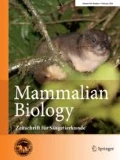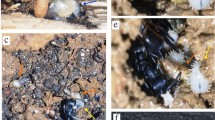Abstract
Based on the content of feces, we studied the food habits of the endangered rodent Chinchitta lanigera. On a seasonal basis, during two years of contrasting rain levels (1992 = 242 mm; 1993 = 123 mm), we collected chinchilla feces from El Cuyano ravine, adjacent to the Chinchilla National Reserve in north central Chile (31° 29′10.8t” S, 71°03′43.9t” W). The main plant species eaten was the perennial graminoid Nassetta chilensis. Chinchillas showed a broader trophic niche during the rainy year, than during the dry year, consuming 55.5 and 40.7% of the 38 and 27 plants available, respectively. Within the wet year the diet differed less between winter and summer (Horn similarity index R0 = 0.58) than within the dry year (R0 = 0.83). Between years, the diet differed more during winters (R0 = 0.20) than during summers (R0 = 0.52). Chinchillas are folivorous, using a feeding pattern of a generalist species. The opportunistic feeding behavior of chinchillas may be an adaptation to the harsh conditions and high variability in food availability triggered by fluctuations in rainfall among years in the arid north central Chile.
Zusammenfassung
Anhand der Zusammensetzung von Kotproben studierten wir die Ernährungsgewohnheiten des gefährdeten Nagers Chinchilla lanigera. In zwei Jahren unterschiedlicher Niederschlagshäufigkeit (1992: 242 mm; 1993: 123 mm) sammelten wir in verschiedenen Jahreszeiten Chinchilla-Kotproben in der El Cuyano-Schlucht, die an das Chinchilla-National-Reservat im nördlichen Zentral-Chile (31° 29′10.8″ S, 71° 03′43,9″ W) angrenzt. Die wesentliche Futterpflanze ist die mehrjährige Gramineen-Art Nassella chilensis. Chinchillas zeigten während des niederschlagsreicheren Jahres eine weitere trophische Nische als während des Trockenjahres. Beobachtet wurden die Nutzung von 55,5% bzw. 40,7% von jeweils 38 bzw. 27 verfügbaren Pflanzen. Während des niederschlagsreicheren Jahres variierte die Nahrungszusammensetzung zwischen Winter und Sommer weniger (Horn-Index R0 = 0,58) als während des Trockenjahres (R0 = 0,83). Im mehrjährigen Vergleich sind größere Unterschiede im Winter (R0 = 0,20) als im Sommer (R0 = 0,52) zu beobachten. Chinchillas sind herbivore Generalisten, deren opportunistische Ernährungsgewohnheiten als Anpassung an die Aridität und die niederschlagsbedingten Änderungen im Nahrungsangebot im nördlichen Zentral-Chile zu deuten sind.
Similar content being viewed by others
References
Baumgartner, L. L.; Martin, A. C. (1939): Plant histology as an aid in squirrel food-habit studies. J. Wildlife Manage. 3, 266–268.
Brower, J. E.; Zar, J. H. (1984): Field and La-boratory Methods for General Ecology. Dubuque, Iowa: W. C. Brown Publishers.
Fuentes, E. R.; Hajek, E. R.; Espinoza, G. (1988): Same consequences of rainfall variability for mediterranean-type ecosystems in Chile. In: Proceedings of the 5th International Conference on Mediterranean Ecosystems: time scales and water stress. Ed. by F. Di Castri, C. Floret, S. Rambal, and J. Roy. Paris: Internat. Union Biol. Sci. Pp. 342–360.
Gajardo, R. (1978): Antecedentes preliminares para la determinación de la comunidades vegetales presentes en Aucó. (Ilapel, IV Región). Ciencias Forestales (Chile) 1, 19–27.
Gutiérrez, J. R.; Meserve, R. L.; Herrera, S.; Contreras, L. C.; Jaksic, F. (1997): Effects of small mammals and vertebrate predators on vegetation in the Chilean semiarid zone. Oecologia 109, 398–406.
Hajek, E. R.; di Castri, F. (1976): Bioclimatografía de Chile. Santiago, Chile: Dirección de investigación de la vice-rectoría académica, Universidad Católica de Chile.
Horn, H. S. (1966): Measurement of “overlap” in comparative ecological studies. Am. Nat. 100, 419–424.
Jiménez, J. (1990): Bases biológicas para la conservación y el manejo de la chinchilla chilena silvestre. Proyecto conservacicón de la chinchilla chilena (Chinchilla lanigera). CO-NAF-WWF 1297. Final report, March 1987-February 1990. CONAF IV Región, Chile.
Jiménez, J. E. (1994): Overuse and endangerment of wildlife: the case of Chilean mammals. Medio Ambiente (Chile) 12, 102–110.
Jiménez, J. E. (1995): Conservation of the last wild chinchilla (Chinchilla lanigera) archipelago: a metapopulation approach. Vida Silvestre Neotropical 4, 89–97.
Jiménez, J. E. (1996): The extirpation and current status of wild chinchillas Chinchilla lanigera and C brevicaudata. Biol. Conserv. 77, 1–6.
Jiménez, J. E.; Feinsinger, P.; Jaksic, F. M. (1992): Spatiotemporal patterns of an irruption and decline of small mammals in northcentral Chile. J. Mammalogy 73, 356–364.
Meserve, P. L. (1976): Food relationships of rodent fauna in a California coastal sage scrub community. J. Mammalogy 57, 300–319.
Mohlis, C. (1983): Información preliminar sobre la conservación y manejo de la chinchilla silvestre en Chile. Boletín Técnico No. 3, Corporación Nacional Forestal, Santiago, Chile.
Serra, M. T. (1979): Composición botanica y variación estacional de la alimentación de Chinchilla lanigera en condiciones naturales. Ciencias Forestales (Chile) 1, 11–18.
Shannon, C. E.; Weaver, W. (1949): The Mathematical Theory of Communication. Urbana, Illinois: University of Illinois Press.
Sparks, D. R.; Malechek, J. C. (1968): Estimating percentage dry weight in diets using a microscopic technique. J. Range Manage. 21, 264–265.
Veloso, C.; Bozinovic, F. (1993): Dietary and digestive canstraints on basal energy metabolism in a small herbivorous rodent. Ecology 74, 2003–2010.
Author information
Authors and Affiliations
Corresponding author
Rights and permissions
About this article
Cite this article
Cortés, A., Miranda, E. & Jiménez, J.E. Seasonal food habits of the endangered long-tailed chinchilla (Chinchilla lanigera): the effect of precipitation. Mamm Biol 67, 167–175 (2002). https://doi.org/10.1078/1616-5047-00024
Received:
Accepted:
Published:
Issue Date:
DOI: https://doi.org/10.1078/1616-5047-00024




